Best
AFFORDABLE VIOLIN
-
Overall: High-end features at an entry-level price with hand-carved maple and spruce body
-
Best Feature: Rosewood chinrest, pegs, and hardwood fingerboard
-
TedScore™: 8.8/10
Best
BEGINNER VIOLIN
-
Overall: Professionally adjusted and set up with premium Helicore strings
-
Best Feature: 4/4-size violin with a lightweight case, real Brazilwood bow, and Schwarz rosin
-
TedScore™: 8.7/10
Best
INTERMEDIATE VIOLIN
-
Overall: Produces a rich, broad sound with broad fundamentals and ear-grabbing overtones
-
Best Feature: Designed by master luthier Thomas Boehme
-
TedScore™: 9/10
Before I became a professional violinist, the journey of learning to play the violin was filled with lots of time learning how to read violin music.
So, if you happen to be one of the people taking on this journey, one of the most important things you need to learn is the violin notes chart – a chart showing all the notes on the violin fingerboard.
Before you can serenade the stars or charm the hearts of your audience, you need to understand violin notes and where to find them on the fingerboard.
You might find it scary to think of all the violin-fingering charts, notes, and violin scales that you need to memorize.
Not to mention the violin lessons you must go through to transform from an absolute beginner to an amazing violin virtuoso!
Don’t worry! I totally get the feeling, and I really would like to help you. So read on…
Understanding the Basics
When you’re starting on the violin, getting to grips with the instrument’s layout and how to produce notes is crucial.
Let’s break down the essentials of the violin’s anatomy, learning its notes, and mastering the first position.
Anatomy of a Violin

Your violin comprises various parts, each contributing to the creation of sound.
Fingerboard: this is where your fingers will dance to produce different pitches.
Nut: it is a small raised bar that supports the strings at the end closest to the pegbox, above the fingerboard.
A string of violin has its own name from highest to lowest pitch:
E string
A string
D string
G string
Remember, understanding these parts is your first step toward making beautiful music!
Learning the Notes
The notes on the violin span across four strings and change with the placement of your fingers.
Starting with open strings – that’s when you play a string without touching it with any fingers – you’ll progress to using your left hand to alter pitches.
For the first position notes, which is where your hand is closest to the nut, you need to remember these to play various notes:
Use your index finger for the first finger (finger number 1)
Use your middle finger for the second finger (finger number 2)
Use your ring finger for the third finger (finger number 3)
Use your pinky finger for the fourth finger (finger number 4)
Mastering First Position
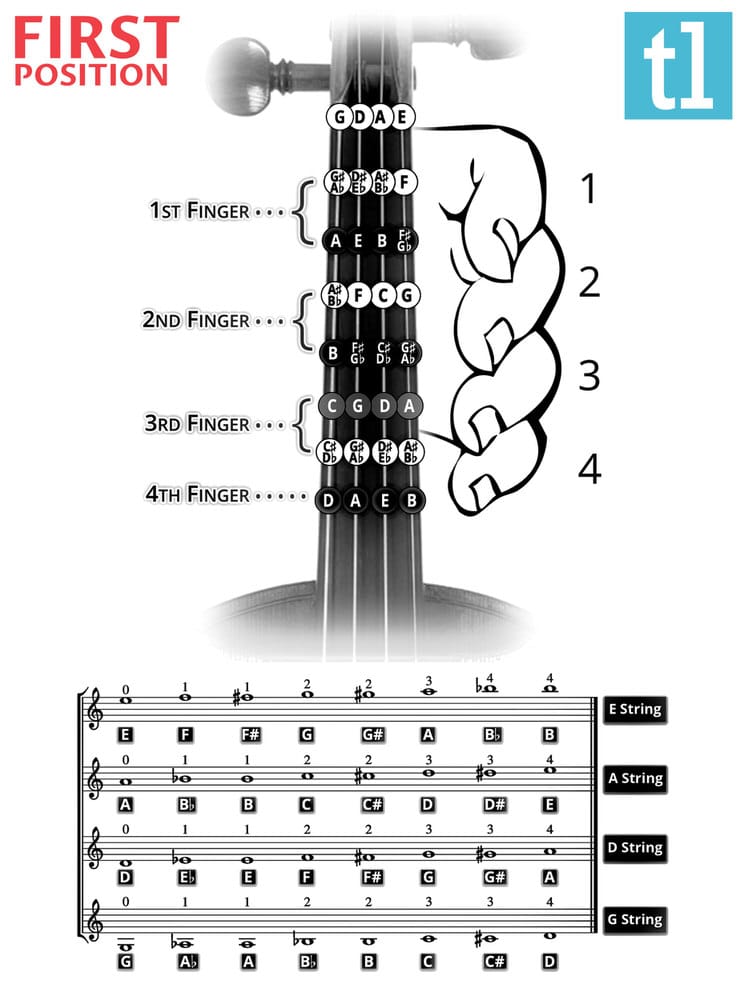
Now, after learning the correct finger positioning for playing notes, you must know that accurate finger placement is VERY important (I can’t emphasize this enough!) to play the 1st position effectively.
Your fingers should be curved and nimble, poised to press the strings with just the right pressure.
A violin fingering chart is incredibly handy in this phase; it shows where to place your fingers on the fingerboard for each note.
As a beginner, refer to this fingering chart frequently (you can find free violin fingering charts on the internet!) while you practice to ensure you’re playing the correct notes – it’s a bit like having a musical map for your fingers!
Advanced Techniques
When you get the hold of learning to play the notes chard, aim to master advanced techniques on the violin.
This will certainly elevate your performance beyond the basics and hone your skills on more challenging concepts.
Exploring Positions and Scales
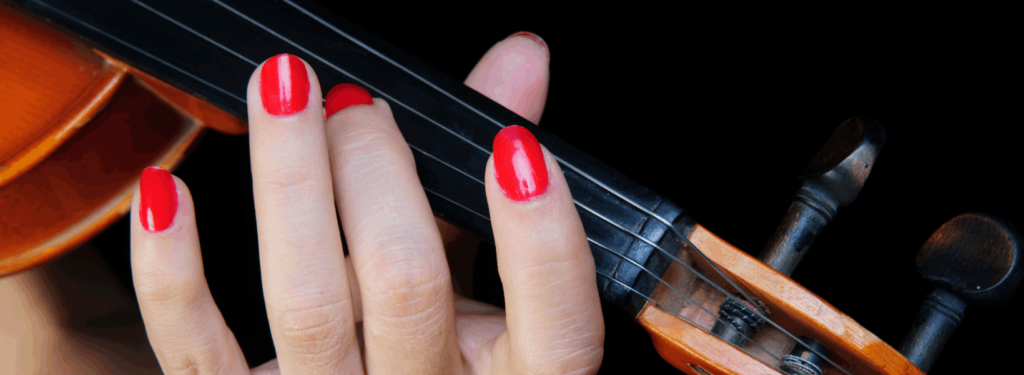
Beyond the familiar first position, exploring further up the fingerboard is essential.
Don’t be afraid to leave your comfort zone and encounter other positions, like the versatile third position, which is crucial for expanding your range.
Also, become friends with scales in every key, like the G major scale or the trickier F major, to build a solid foundation.
Another thing is that a mastery of both sharps and flats, along with their respective high and low finger placements, ensures a rich musical vocabulary.
For example, getting comfortable with a high 3 on the A string or a low 2 on the E can totally change your game!
Reading Sheet Music
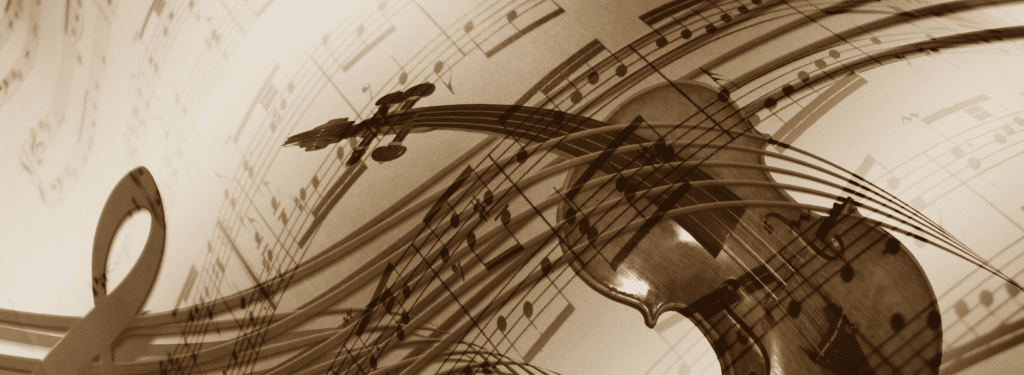
Reading sheet music is more than just recognizing notes; it’s deciphering the blueprint of a musical masterpiece.
Trust me, you’ll easily navigate through key signatures, from C major’s clean slate to D major’s two sharp notes.
Fluency in music theory, including understanding key signatures and accidentals, is a must!
Get used to the musical stave (if wizards have magical staff, these are your musical staff!), where every line and space holds the secret to a note’s pitch.
Improving Intonation and Technique
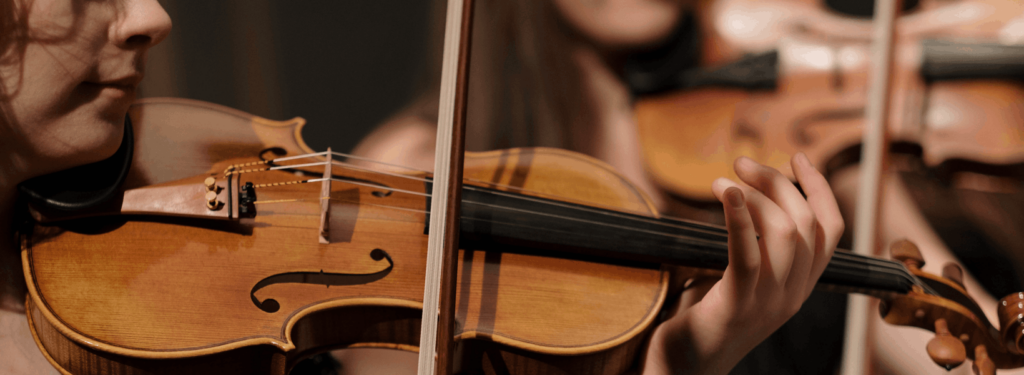
Intonation is the heart of your musical expression, and perfecting it requires a keen ear and a steady hand.
Shifting between positions should become second nature so you can focus on the music, not the mechanics.
Coordination, hand frame, and muscle memory lead your technique toolkit. Enhancing these through rigorous practice will solidify your hand positions and pave the way for flawless performances.
Violins I Highly Recommend
If you need an instrument to practice everything that is written here, from the violin fingerboard to the violin finger positions, you might want to check these highly recommended violins.
GEWA Guarneri Model La Companella Soloist Professional Violin

FEATURES: Produces a rich, broad sound with broad fundamentals and ear-grabbing overtones
OTHER INFO: Grained spruce top has been meticulously calibrated for optimal sonic performance
- Designed by master luthier Thomas Boehme
- Hand-selected, beautifully flamed sycamore maple back
- Inlaid purfling, an ebony fingerboard, and boxwood fittings
- None!
When you click ‘Check Price’, you’ll see there are loads of great places to buy this item. Our personal favorite is Sweetwater for the US, and Thomann and Gear4Music for the UK & Europe.
They are the largest music retailers, with excellent customer service, competitive prices, really fast shipping, and the longest guarantees.
The professional musician who wrote this article combined many things,
from the product build, manufacturer’s reputation through to feedback
from other users, to create our famous TedScore™.
I recently tried the GEWA Guarneri Model La Companella Soloist Professional Violin, and I am thoroughly impressed with its rich, warm tone and exceptional craftsmanship. Playing this violin feels effortless, and it truly sings with a resonant, full-bodied sound that enhances my performance.
Primavera 90 Violin Outfit, Full Size With Accessory Pack

FEATURES: High-end features at an entry-level price
OTHER INFO: Hand-carved maple and spruce body
- Rosewood chinrest, pegs, and hardwood fingerboard
- Includes a case, bow, and rosin
- No Cons at all!
When you click ‘Check Price’, you’ll see there are loads of great places to buy this item. Our personal favorite is Sweetwater for the US, and Thomann and Gear4Music for the UK & Europe.
They are the largest music retailers, with excellent customer service, competitive prices, really fast shipping, and the longest guarantees.
The professional musician who wrote this article combined many things,
from the product build, manufacturer’s reputation through to feedback
from other users, to create our famous TedScore™.
I always recommend the Primavera 90 Violin Outfit in full size to my students because it’s been a fantastic choice for entry-level players; the sound is clear, and it holds its tuning well. The included accessory pack with the case, bow, and rosin is also very helpful and convenient to start playing immediately.
Yamaha AV7-44SG Student Violin Outfit

FEATURES: 4/4-size violin with a lightweight case, real Brazilwood bow, and Schwarz rosin
OTHER INFO: Spruce top and maple back/sides have been aged over five years for enhanced tonal richness and resonance
- Ebony tuning pegs, fingerboard, tailpiece, and chinrest
- Wittner Ultra tailpiece with four fine tuners
- Professionally adjusted and set up with premium Helicore strings
- String comes with a steel core, which can be upgraded to preferred strings
When you click ‘Check Price’, you’ll see there are loads of great places to buy this item. Our personal favorite is Sweetwater for the US, and Thomann and Gear4Music for the UK & Europe.
They are the largest music retailers, with excellent customer service, competitive prices, really fast shipping, and the longest guarantees.
The professional musician who wrote this article combined many things,
from the product build, manufacturer’s reputation through to feedback
from other users, to create our famous TedScore™.
As a violin teacher, I highly recommend the Yamaha AV7-44SG 4/4 Size Student Violin Outfit to my students for its consistent quality and playability, which are essential for developing good technique. The outfit comes with everything a student needs to get started, and the violin itself produces a beautiful tone that encourages daily practice.
Violin Notes Chart
Summary
Remember, a violin notes chart is one of your best friends on this journey!
A chart lets you see which finger goes where for each note—like a musical roadmap for your fingertips.
And to give you an extra tip, check this out, and don’t forget these:
Open Strings: G, D, A, E
First Finger: A on G string, E on D string, B on A string, F♯ on E string
Second Finger: B on G string, F♯ on D string, C♯ on A string, G♯ on E string
Third Finger: C on G string, G on D string, D on A string, A on E string
Fourth Finger: D on the G string, A on the D string, E on the A string, B on the E string
Isn’t it fascinating that the fourth finger on one string is the same note as the next open string? With each finger placement, the pitch gets higher, just like the chart shows.
Placing your fingers on the violin feels like a dance, and the chart helps you remember the moves. It’s all about patterns and sequences, and before you know it, you’ll be reading music and charts like a pro.
After getting comfy with the basics, you’ll see how the notes connect and flow. You’ll start feeling more confident with your violin, which is totally amazing!
Just stick with it, and those notes will become second nature!
Before you go…
Take a look at my new article, the Top 9 Best Violin Shoulder Rests.
FAQ's
Violinists know where to put their fingers on the fingerboard primarily through muscle memory and auditory feedback. As beginners, they learn the correct placement through extensive practice, starting with visual aids such as tape markers and gradually relying on the feel of the string’s vibration and the sound produced. Over time, they develop a precise sense of intonation, allowing them to subtly adjust finger positions to produce the desired pitch without needing frets or visual cues.










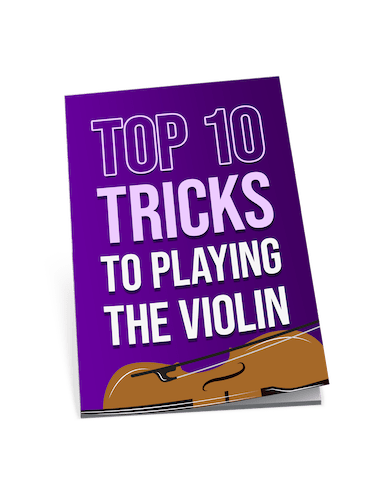
been trying to learn violin on my own and this is the first time someone explained scales in a way that makes sense. always thought it was way too complex, but reading your piece kinda clicked something in my brain. do have videos or something to follow along?
I found the section on improving intonation and technique particularly useful. It’s given me a better understanding of what my daughter is working on and how I might support her practice at home. Excellent article, Kate .
That violin notes chart is a lifesaver! Been struggling to remember all of them lol
Hey Kate Telfer, just read your piece on mastering the first position on violin. It’s pretty good stuff. But, could you maybe go a bit more into how to transition smoothly between notes? I keep getting this scratchy sound every time I try.
Hey AlexTheMuso, but I might help. That scratchy sound is pretty common for beginners. It usually means you need to work on bow pressure and speed. Start slow, focus on consistent pressure, and speed up gradually. Practice makes perfect!